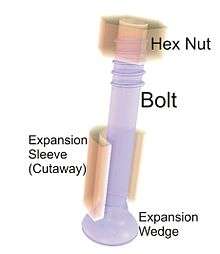Anchor bolt

An anchor bolt is used to attach objects or structures to concrete. There are many types of anchor bolts, consisting of designs that are mostly proprietary to the manufacturing companies. All consist of a threaded end, to which a nut and washer can be attached for the external load.[1] Anchor bolts are extensively used on all types of projects, from standard buildings to dams and nuclear power plants.[2] They can also be used to firmly affix embed plates to a concrete foundation when used with a structural steel element.[3]
The simplest anchor bolt is a cast-in-place anchor. As seen in the figure, most designs consist of a standard bolt with a hexagonal head, which is cast in the wet concrete before it sets. There are other designs, some consisting of a bent bolt with a hook on the end, or some other sort of bending. Cast-in-place anchor bolts are the strongest type of fastener, but the casting is difficult, and they are usually only used for heavy machines mounted on poured concrete floors. Another use of this anchor bolt is to connect the concrete foundation of a building to its wall. With this, the building is more resistant to earthquakes. Currently there are several devices to assist in holding and in placing anchor bolt to set in the concrete. These devices are mostly made from composite plastic. Once the concrete has been poured and set, the only other types of bolts that can be used are mechanical and epoxy bolts. Epoxy bolts are the strongest, but can be very tricky to install, since the epoxy has to be mixed to exact specifications, the hole must be very clean, and the set time has to be watched. As well, there must be a rigorous testing program. In Boston's Big Dig project, these procedures were not well carried out, which resulted in a large concrete slab crushing a motorist.
A concrete screw is another way of attaching things to concrete that has already been poured and set.
Wedge anchors

Wedge anchors, also known as expansion bolts and expansion anchors, secure themselves using a mechanical wedging effect at the end of the fastener. There are three basic styles of wedge anchors: fully threaded, partial threaded and the full-bodied wedge anchor.[4] As shown in the figure, tightening the bolt results in a wedge being driven up against a sleeve. This jams the end of the bolt, and provides the strength. Many different manufacturers provide a variation on this theme, usually depending on the condition of the concrete, and the type of load. If a mechanical anchor fails, it is usually in the form of pulling out a wedge of concrete, and for this reason, proper design looks at the depth of embedment and ensures that the bolts are not spaced too closely.
A specialized form of the anchor bolt is the rock bolt, used in rock excavations. In many parts of the world seismic anchors are another specialized subject.[5]
Gallery
See also
References
| Wikimedia Commons has media related to Anchor bolts. |
- ↑ http://www.gobrick.com/BIA/technotes/t44.htm
- ↑ "Where anchor bolts are used". US Bureau of Reclamation. Retrieved November 2010.
- ↑ Anchor Bolts Piping Technology & Products, (retrieved May 2012)
- ↑ "Fine Points on Selecting and Installing Wedge Anchors". Concrete Fastener. Retrieved November 2010.
- ↑ http://web.archive.org/web/20080408144424/http://www.ce.berkeley.edu/~epp/clad/node3.html
External links
- "Bolt Expands in Concrete to Anchor Fixtures" Popular Mechanics, February 1935 bottom-left pg. 224

